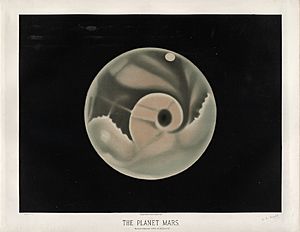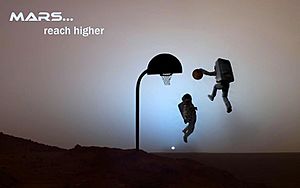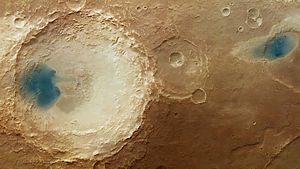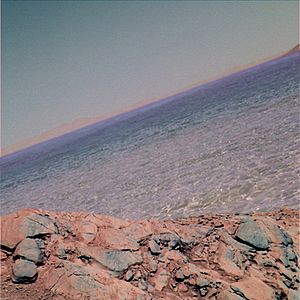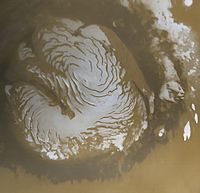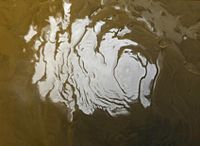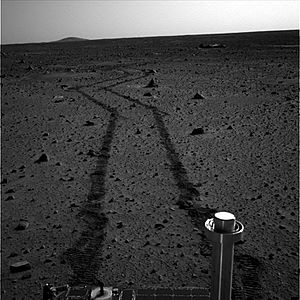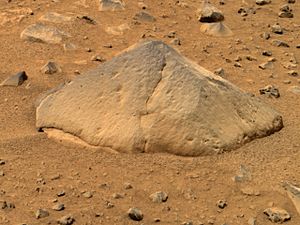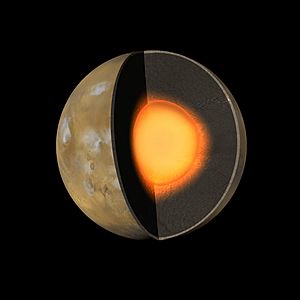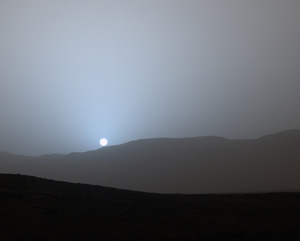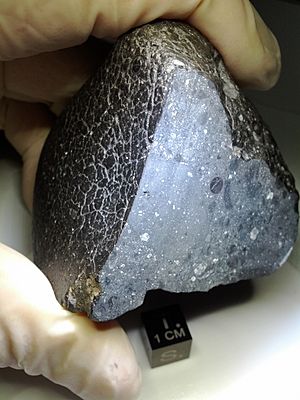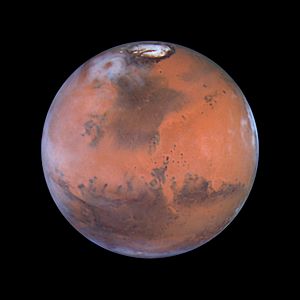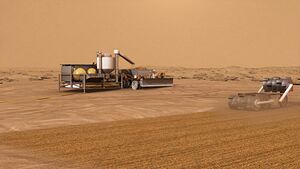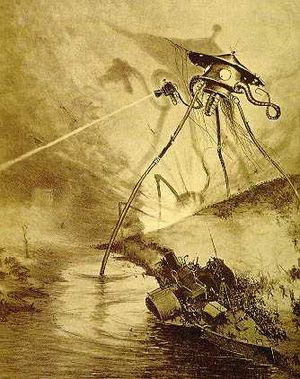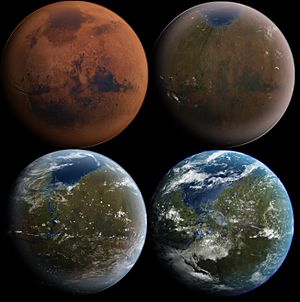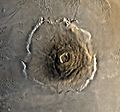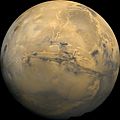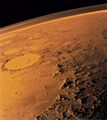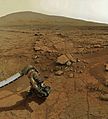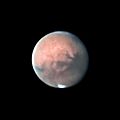Mars facts for kids
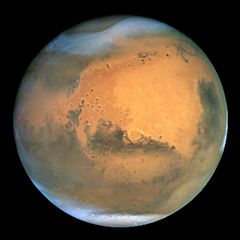
Mars as seen by the Hubble Space Telescope
|
|||||||||||||
| Designations | |||||||||||||
|---|---|---|---|---|---|---|---|---|---|---|---|---|---|
| Adjectives | Martian | ||||||||||||
| Orbital characteristics | |||||||||||||
| Epoch J2000 | |||||||||||||
| Aphelion | 249,209,300 km 1.665 861 AU |
||||||||||||
| Perihelion | 206,669,000 km 1.381 497 AU |
||||||||||||
| 227,939,100 km 1.523 679 AU |
|||||||||||||
| Eccentricity | 0.093 315 | ||||||||||||
| 686.971 days 1.8808 Earth years |
|||||||||||||
| 779.96 day 2.135 Julian years |
|||||||||||||
|
Average orbital speed
|
24.077 km/s | ||||||||||||
| Inclination | 1.850° to ecliptic 5.65° to Sun's equator 1.67° to invariable plane |
||||||||||||
| 49.562° | |||||||||||||
| 286.537° | |||||||||||||
| Known satellites | 2 | ||||||||||||
| Physical characteristics | |||||||||||||
|
Mean radius
|
3,389.5±0.2 km | ||||||||||||
| Flattening | 0.005 89 ± 0.000 15 | ||||||||||||
| 144,798,500 km² 0.284 Earths |
|||||||||||||
| Volume | 1.6318×1011 km³ 0.151 Earths |
||||||||||||
| Mass | 6.4185×1023 kg 0.107 Earths |
||||||||||||
|
Mean density
|
3.934 g/cm³ | ||||||||||||
| 5.027 km/s | |||||||||||||
|
Sidereal rotation period
|
1.025 957 day 24.622 96 h |
||||||||||||
|
Equatorial rotation velocity
|
868.22 km/h (241.17 m/s) | ||||||||||||
| 25.19° | |||||||||||||
|
North pole right ascension
|
21 h 10 min 44 s 317.681 43° |
||||||||||||
|
North pole declination
|
52.886 50° | ||||||||||||
| Albedo | 0.15 (geometric) or 0.25 (bond) | ||||||||||||
|
|||||||||||||
| +1.8 to −2.91 (brightness in the sky) | |||||||||||||
| 3.5—25.1" | |||||||||||||
| Atmosphere | |||||||||||||
|
Surface pressure
|
0.6–1.0 kPa | ||||||||||||
| Composition by volume | 95.72% Carbon dioxide 2.7% Nitrogen |
||||||||||||
Mars is the fourth planet from the Sun and the second-smallest planet in the Solar System after Mercury. In English, Mars carries a name of the Roman god of war, and is often referred to as the "Red Planet" because the reddish iron oxide prevalent on its surface gives it a reddish appearance that is distinctive among the astronomical bodies visible to the naked eye. Mars can easily be seen from Earth, as can its reddish coloring.
Mars is a terrestrial planet with a thin atmosphere, having surface features like those of the impact craters of the Moon, and valleys, deserts, and polar ice caps of Earth It has two moons, Phobos and Deimos, which are small and irregularly shaped.
It is nearly 7,000 kilometres (km) wide; just over half the width of the Earth. Its volume is about 15% of the Earth. Since a lot of the Earth is covered by water, the total surface area of the Mars is nearly as large as all of the land on the Earth. It is possible that its size may eventually permit human colonies.
Contents
Ancient and medieval studies
Our records of watching and recording Mars started with ancient Egyptian astronomers in the 2nd millennium BC.
Detailed observations of the location of Mars were made by Babylonian astronomers who developed methods using math to predict the future position of the planet. The ancient Greek philosophers and astronomers developed a model of the solar system with the Earth at the center ('geocentric'), instead of the sun. They used this model to explain the planet's motions. Indian and Islamic astronomers estimated the size of Mars and its distance from Earth. Similar work was done by Chinese astronomers.
In the 16th century, Nicholas Copernicus proposed a model for the Solar System in which the planets follow circular orbits about the Sun. This 'heliocentric' model was the beginning of modern astronomy. It was revised by Johannes Kepler, who gave an elliptical orbit for Mars which better fit the data from our observations.
The first observations of Mars by telescope was by Galileo Galilei in 1610. Within a century, astronomers discovered distinct albedo features (changes in brightness) on the planet, including the dark patch and polar ice caps. They were able to find the planet's day (rotation period) and axial tilt. Better telescopes developed early in the 19th century allowed permanent Martian features to be mapped in detail. The first crude map of Mars was published in 1840, followed by better maps from 1877 onward.
Yellow clouds on Mars have been observed since the 1870s, which were windblown sand or dust. During the 1920s, the range of Martian surface temperature was measured; it ranged from –85 to 7 oC. The planetary atmosphere was found to be arid with only traces of oxygen and water. In 1947, Gerard Kuiper showed that the thin Martian atmosphere contained extensive carbon dioxide; roughly double the quantity found in Earth's atmosphere. The first standard naming of Mars surface features was set in 1960 by the International Astronomical Union.
Physical characteristics
Gravity
If you were on Mars, you would be lighter, as Mars' gravity only has a force about two fifths as strong as the that of Earth's. You could lift objects that weigh almost three times as much compared to similar objects here on the Earth. You could jump up almost three times higher, and it would take much longer to fall to the ground from the same height. Even so there are some things you couldn't do. Although a big rock would weigh less and you could pick it up, it would still have the same mass. If you tried to catch it, it would knock you over, and if it landed on you it would crush you.
Atmosphere
Mars lost its magnetosphere 4 billion years ago, possibly because of numerous asteroid strikes, so the solar wind interacts directly with the Martian ionosphere, lowering the atmospheric density by stripping away atoms from the outer layer.
Mars has a very thin atmosphere with barely any oxygen (it is mostly carbon dioxide). The atmosphere of Mars consists of about 96% carbon dioxide, 1.93% argon and 1.89% nitrogen along with traces of oxygen and water, Methane has been detected in the Martian atmosphere. Methane can exist in the Martian atmosphere for only a limited period before it is destroyed—estimates of its lifetime range from 0.6–4 years. Its presence despite this short lifetime indicates that an active source of the gas must be present. Volcanic activity, cometary impacts, and the presence of microbial life forms are among possible sources. Mars's atmosphere is too thin to protect Mars from meteors, which is why the lower half of Mars has so many craters.
The atmosphere is quite dusty, containing incredibly tiny particles which give the Martian sky a tawny color when seen from the surface. It may take on a pink hue due to iron oxide particles suspended in it. Because there is an atmosphere, however thin it is, the sky does change colour when the sun rises and sets.
When Mars comes closest to the Sun, the atmosphere can stir up storms of dust. Mars has the largest dust storms in the Solar System. These can vary from a storm over a small area, to some storms that are so gigantic they can cover the entire planet in clouds of dust. Dust storms on Mars can last for hundreds of days, with wind speeds of up to 200 kilometres per hour, and have been shown to increase the global temperature. Huge storms like these have been seen from the Earth through telescopes.
Water on Mars
Liquid water is necessary for life and metabolism, so if water was present on Mars, the chances of life evolving is improved. The Viking orbiters found evidence of possible river valleys in many areas, erosion and, in the southern hemisphere, branched streams. Since then, rovers and orbiters have also looked closely and eventually proved water was on the surface at one time, and is still found as ice in the polar ice caps and underground.
Liquid water cannot exist on the surface of Mars due to low atmospheric pressure, which is less than 1% of the Earth's, except at the lowest elevations for short periods. The two polar ice caps appear to be made largely of water. The volume of water ice in the south polar ice cap, if melted, would be sufficient to cover the entire planetary surface to a depth of 11 meters (36 ft).
In November 2016, NASA reported finding a large amount of underground ice in the Utopia Planitia region of Mars. The volume of water detected has been estimated to be equivalent to the volume of water in Lake Superior.
Mars does not have any liquid water on the surface now, but signs of run-off on the surface were probably caused by water. Landforms seen on Mars strongly suggest that liquid water at some time existed on the planet's surface. Huge areas of ground have been scraped and eroded. These are known as 'outflow channels', and cut across the surface in about 25 places.
Polar caps
Like the Earth, Mars has ice caps at its poles. However, they are made from frozen carbon dioxide as well as ice. During the Martian winter at each pole, the cap grows as carbon dioxide from the atmosphere freezes. The cap shrinks again during the Martian summer. As on Earth, when it is winter at one pole it is summer at the other.
Geology
Today, features on Mars are named from a variety of sources. Albedo features (how reflective and bright something is) are named for classical mythology. Craters larger than 60 km are named for deceased scientists and writers and others who have contributed to the study of Mars. Craters smaller than 60 km are named for towns and villages of the world with populations of less than 100,000. Large valleys are named for the word "Mars" or "star" in various languages; small valleys are named for rivers.
Because Mars is the one of the closest planets to Earth in the Solar System, many wondered if there was any kind of life there. Today we know that the kind of life, if any, would be some simple bacteria-type organisms. The surface of Mars is a lot like a desert on Earth; it is very dry and dusty, but it is also very cold.
The outer, rocky surface of Mars is called the crust. Most of the crust is made from basalt, a type of rock made when lava grows cold. Like the Earth, Mars has a thick layer of rock below the crust called the mantle. The mantle is much hotter than the crust, and the mantle rock is partly molten. But the crust on Mars has grown thick, so the lava from the mantle no longer reaches the surface. There are volcanoes on Mars, but they are no longer active.
The planet Mars is made of rock. The ground there is red because of iron oxide (rust) in the rocks and dust. The planet's atmosphere is very thin and contains a lot of carbon dioxide and a very tiny amount of oxygen. The temperatures on Mars are colder than on Earth, because it is farther away from the Sun and has less air to keep warmth in. There is water ice and frozen carbon dioxide at the north and south poles. The average thickness of the planet's crust is about 50 km (31 mi), with a maximum thickness of 125 km (78 mi).
The shield volcano Olympus Mons (Mount Olympus) is an extinct volcano in the vast upland region Tharsis, which contains several other large volcanoes. Olympus Mons is roughly three times the height of Mount Everest, which in comparison stands at just over 8.8 km (5.5 mi).
It is also home to Valles Marineris, the third largest rift system (canyon) in the Solar System, 4,000 km long. It is called a terrestrial planet because its outer layers are made of rocky material like the Earth.
Meteorite craters
After the formation of the planets, all experienced the "Late Heavy Bombardment". About 60% of the surface of Mars shows a record of impacts from that era. Mars is scarred by a number of impact craters: a total of 43,000 craters with a diameter of 5 km (3.1 mi) or greater have been found. The largest confirmed of these is the Hellas impact basin, clearly visible from Earth.
Due to the smaller mass of Mars, the probability of an object colliding with the planet is about half that of Earth. Mars is located closer to the asteroid belt, so it has an increased chance of being struck by materials from that source. Mars is more likely to be struck by short-period comets (those that lie within the orbit of Jupiter). In spite of this, there are far fewer craters on Mars compared with the Moon, because the atmosphere of Mars provides protection against small meteors.
Some meteorites hit Mars with so much force a few pieces of Mars went flying into space – even to Earth. Rocks on Earth are sometimes found which have chemicals that are exactly like the ones in Martian rocks. These rocks also look like they fell really quickly through the atmosphere, so it is reasonable to think they came from Mars.
NASA maintains a catalog of 34 Mars meteorites, that is, meteorites which originally came from Mars. These assets are highly valuable since they are the only physical samples available of Mars.
Studies at NASA's Johnson Space Center show that at least three of the meteorites contain possible evidence of past life on Mars, in the form of microscopic structures resembling fossilized bacteria (so-called biomorphs). Although the scientific evidence collected is reliable, and the rocks are correctly described, what made the rocks look like they do is not clear.
Orbit and rotation
A Martian day is called a sol, and is a little longer than an Earth day. Mars's average distance from the Sun is roughly 230 million km (143 million mi), and its orbital period is 687 (Earth) days. The solar day (or sol) on Mars is only slightly longer than an Earth day: 24 hours, 39 minutes, and 35.244 seconds. A Martian year is equal to 1.8809 Earth years, or 1 year, 320 days, and 18.2 hours.
It rotates on a tilt, just like the Earth does, so it has four different seasons. Of all the planets in the Solar System, the seasons of Mars are the most Earth-like, due to the similar tilts of the two planets' rotational axes. The lengths of the Martian seasons are about twice those of Earth's, because its orbital period is that much longer.
Martian surface temperatures vary from lows of about −143 °C (−225 °F) (at the winter polar caps) to highs of up to 35 °C (95 °F) (in equatorial summer). The wide range in temperatures is due mostly to the thin atmosphere which cannot store much solar heat. The planet is also 1.52 times as far from the Sun as Earth, resulting in just 43% of the amount of sunlight.
Human observations and exploration
The history of observations of Mars is marked by oppositions of Mars when the planet is closest to Earth and hence is most easily visible, which occur every couple of years. Even more notable are the perihelic oppositions of Mars, which are distinguished because Mars is close to perihelion, making it even closer to Earth.
Ancient and medieval observations

The ancient Sumerians named Mars Nergal, the god of war and plague. During Sumerian times, Nergal was a minor deity of little significance, but, during later times, his main cult center was the city of Nineveh. In Mesopotamian texts, Mars is referred to as the "star of judgement of the fate of the dead". The existence of Mars as a wandering object in the night sky was also recorded by the ancient Egyptian astronomers and, by 1534 BCE, they were familiar with the retrograde motion of the planet. By the period of the Neo-Babylonian Empire, the Babylonian astronomers were making regular records of the positions of the planets and systematic observations of their behavior. For Mars, they knew that the planet made 37 synodic periods, or 42 circuits of the zodiac, every 79 years. They invented arithmetic methods for making minor corrections to the predicted positions of the planets. In Ancient Greece, the planet was known as Πυρόεις. Commonly, the Greek name for the planet now referred to as Mars, was Ares. It was the Romans who named the planet Mars, for their god of war, often represented by the sword and shield of the planet's namesake.
In the fourth century BCE, Aristotle noted that Mars disappeared behind the Moon during an occultation, indicating that the planet was farther away. Ptolemy, a Greek living in Alexandria, attempted to address the problem of the orbital motion of Mars. Ptolemy's model and his collective work on astronomy was presented in the multi-volume collection later called the Almagest (from the Arabic for "greatest"), which became the authoritative treatise on Western astronomy for the next fourteen centuries. Literature from ancient China confirms that Mars was known by Chinese astronomers by no later than the fourth century BCE. In the East Asian cultures, Mars is traditionally referred to as the "fire star" based on the Wuxing system.
During the seventeenth century A.D., Tycho Brahe measured the diurnal parallax of Mars that Johannes Kepler used to make a preliminary calculation of the relative distance to the planet. From Brahe's observations of Mars, Kepler deduced that the planet orbited the Sun not in a circle, but in an ellipse. Moreover, Kepler showed that Mars sped up as it approached the Sun and slowed down as it moved farther away, in a manner that later physicists would explain as a consequence of the conservation of angular momentum. When the telescope became available, the diurnal parallax of Mars was again measured in an effort to determine the Sun-Earth distance. This was first performed by Giovanni Domenico Cassini in 1672. The early parallax measurements were hampered by the quality of the instruments. The only occultation of Mars by Venus observed was that of 13 October 1590, seen by Michael Maestlin at Heidelberg. In 1610, Mars was viewed by Italian astronomer Galileo Galilei, who was first to see it via telescope. The first person to draw a map of Mars that displayed any terrain features was the Dutch astronomer Christiaan Huygens.
Martian "canals"

By the 19th century, the resolution of telescopes reached a level sufficient for surface features to be identified. On 5 September 1877, a perihelic opposition to Mars occurred. The Italian astronomer Giovanni Schiaparelli used a 22-centimetre (8.7 in) telescope in Milan to help produce the first detailed map of Mars. These maps notably contained features he called canali, which were later shown to be an optical illusion. These canali were supposedly long, straight lines on the surface of Mars, to which he gave names of famous rivers on Earth. His term, which means "channels" or "grooves", was popularly mistranslated in English as "canals".
Influenced by the observations, the orientalist Percival Lowell founded an observatory which had 30- and 45-centimetre (12- and 18-in) telescopes. The observatory was used for the exploration of Mars during the last good opportunity in 1894, and the following less favorable oppositions. He published several books on Mars and life on the planet, which had a great influence on the public. The canali were independently observed by other astronomers, like Henri Joseph Perrotin and Louis Thollon in Nice, using one of the largest telescopes of that time.
The seasonal changes (consisting of the diminishing of the polar caps and the dark areas formed during Martian summers) in combination with the canals led to speculation about life on Mars, and it was a long-held belief that Mars contained vast seas and vegetation. As bigger telescopes were used, fewer long, straight canali were observed. During observations in 1909 by Antoniadi with an 84-centimetre (33 in) telescope, irregular patterns were observed, but no canali were seen.
Robotic exploration
Dozens of crewless spacecraft, including orbiters, landers, and rovers, have been sent to Mars by the Soviet Union, the United States, Europe, India, the United Arab Emirates, and China to study the planet's surface, climate, and geology. NASA's Mariner 4 was the first spacecraft to visit Mars; launched on 28 November 1964, it made its closest approach to the planet on 15 July 1965. Mariner 4 detected the weak Martian radiation belt, measured at about 0.1% that of Earth, and captured the first images of another planet from deep space.
Once spacecraft visited the planet during NASA's Mariner missions in the 1960s and 1970s, many previous concepts of Mars were radically broken. After the results of the Viking life-detection experiments, the hypothesis of a dead planet was generally accepted. The data from Mariner 9 and Viking allowed better maps of Mars to be made, and the Mars Global Surveyor mission, which launched in 1996 and operated until late 2006, produced complete, extremely detailed maps of the Martian topography, magnetic field and surface minerals. These maps are available online at websites including Google Mars. Both the Mars Reconnaissance Orbiter and Mars Express continued exploring with new instruments and supporting lander missions. NASA provides two online tools: Mars Trek, which provides visualizations of the planet using data from 50 years of exploration, and Experience Curiosity, which simulates traveling on Mars in 3-D with Curiosity.
As of 2023[update], Mars is host to ten functioning spacecraft. Eight are in orbit: 2001 Mars Odyssey, Mars Express, Mars Reconnaissance Orbiter, MAVEN, ExoMars Trace Gas Orbiter, the Hope orbiter, and the Tianwen-1 orbiter. Another two are on the surface: the Mars Science Laboratory Curiosity rover and the Perseverance rover.
Planned missions to Mars include:
- NASA's EscaPADE spacecraft, planned to launch in late 2024.
- The Rosalind Franklin rover mission, designed to search for evidence of past life, which was intended to be launched in 2018 but has been repeatedly delayed, with a launch date pushed to 2028 at the earliest. The project was restarted in 2024 with additional funding.
- A current concept for a joint NASA-ESA mission to return samples from Mars would launch in 2026.
As of February 2024[update], debris from these types of missions has reached over seven tons. Most of it consists of crashed and inactive spacecraft as well as discarded components.
In April 2024, NASA selected several companies to begin studies on providing commercial services to further enable robotic science on Mars. Key areas include establishing telecommunications, payload delivery and surface imaging. Template:Mars map indicating landers
Habitability and the search for life
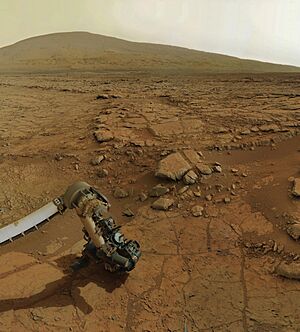
During the late 19th century, it was widely accepted in the astronomical community that Mars had life-supporting qualities, including the presence of oxygen and water. However, in 1894 W. W. Campbell at Lick Observatory observed the planet and found that "if water vapor or oxygen occur in the atmosphere of Mars it is in quantities too small to be detected by spectroscopes then available". That observation contradicted many of the measurements of the time and was not widely accepted. Campbell and V. M. Slipher repeated the study in 1909 using better instruments, but with the same results. It was not until the findings were confirmed by W. S. Adams in 1925 that the myth of the Earth-like habitability of Mars was finally broken. However, even in the 1960s, articles were published on Martian biology, putting aside explanations other than life for the seasonal changes on Mars.
The current understanding of planetary habitability – the ability of a world to develop environmental conditions favorable to the emergence of life – favors planets that have liquid water on their surface. Most often this requires the orbit of a planet to lie within the habitable zone, which for the Sun is estimated to extend from within the orbit of Earth to about that of Mars. During perihelion, Mars dips inside this region, but Mars's thin (low-pressure) atmosphere prevents liquid water from existing over large regions for extended periods. The past flow of liquid water demonstrates the planet's potential for habitability. Recent evidence has suggested that any water on the Martian surface may have been too salty and acidic to support regular terrestrial life.
The environmental conditions on Mars are a challenge to sustaining organic life: the planet has little heat transfer across its surface, it has poor insulation against bombardment by the solar wind due to the absence of a magnetosphere and has insufficient atmospheric pressure to retain water in a liquid form (water instead sublimes to a gaseous state). Mars is nearly, or perhaps totally, geologically dead; the end of volcanic activity has apparently stopped the recycling of chemicals and minerals between the surface and interior of the planet.
Evidence suggests that the planet was once significantly more habitable than it is today, but whether living organisms ever existed there remains unknown. The Viking probes of the mid-1970s carried experiments designed to detect microorganisms in Martian soil at their respective landing sites and had positive results, including a temporary increase in CO
2 production on exposure to water and nutrients. This sign of life was later disputed by scientists, resulting in a continuing debate, with NASA scientist Gilbert Levin asserting that Viking may have found life. A 2014 analysis of Martian meteorite EETA79001 found chlorate, perchlorate, and nitrate ions in sufficiently high concentrations to suggest that they are widespread on Mars. UV and X-ray radiation would turn chlorate and perchlorate ions into other, highly reactive oxychlorines, indicating that any organic molecules would have to be buried under the surface to survive.
Small quantities of methane and formaldehyde detected by Mars orbiters are both claimed to be possible evidence for life, as these chemical compounds would quickly break down in the Martian atmosphere. Alternatively, these compounds may instead be replenished by volcanic or other geological means, such as serpentinite. Impact glass, formed by the impact of meteors, which on Earth can preserve signs of life, has also been found on the surface of the impact craters on Mars. Likewise, the glass in impact craters on Mars could have preserved signs of life, if life existed at the site.
Human mission proposals
Several plans for a human mission to Mars have been proposed throughout the 20th and 21st centuries, but none have come to fruition. The NASA Authorization Act of 2017 directed NASA to study the feasibility of a crewed Mars mission in the early 2030s; the resulting report eventually concluded that this would be unfeasible. In addition, in 2021, China was planning to send a crewed Mars mission in 2033. Privately held companies such as SpaceX have also proposed plans to send humans to Mars, with the eventual goal to settle on the planet.As of 2024, SpaceX has proceeded with the development of the Starship launch vehicle with the goal of Mars colonization. In plans shared with the company in April 2024, Elon Musk envisions the beginning of a Mars colony within the next twenty years. This enabled by the planned mass manufacturing of Starship and initially sustained by resupply from Earth, and in situ resource utilization on Mars, until the Mars colony reaches full self sustainability.Any future human mission to Mars will likely take place within the optimal Mars launch window, which occurs every 26 months. The moon Phobos has been proposed as an anchor point for a space elevator. Besides national space agencies and space companies, there are groups such as the Mars Society and The Planetary Society that advocates for human missions to Mars.
Popular culture
The depiction of Mars in fiction has been stimulated by its dramatic red color and by nineteenth century scientific idea's that its surface conditions might support not just life but intelligent life. Thus originated a large number of science fiction stories, among which is H. G. Wells' The War of the Worlds, published in 1898, in which Martians seek to escape their dying planet by invading Earth.
Influential works included Ray Bradbury's The Martian Chronicles, in which human explorers accidentally destroy a Martian civilization, Edgar Rice Burroughs' Barsoom series, C. S. Lewis' novel Out of the Silent Planet (1938), and a number of Robert A. Heinlein stories before the mid-sixties.
Jonathan Swift made reference to the moons of Mars, about 150 years before their actual discovery by Asaph Hall, detailing reasonably accurate descriptions of their orbits, in the 19th chapter of his novel Gulliver's Travels.
A comic figure of an intelligent Martian, Marvin the Martian, appeared in Haredevil Hare (1948) as a character in the Looney Tunes animated cartoons of Warner Brothers, and has continued as part of popular culture to the present.
After the Mariner and Viking spacecraft had returned pictures of Mars as it really is, an apparently lifeless world, these ideas about Mars had to be abandoned, and a trend for accurate, realist depictions of human colonies on Mars developed, the best known of which may be Kim Stanley Robinson's Mars trilogy. Theories about the Face on Mars and other mysterious landmarks spotted by space probes have meant that ancient civilizations continue to be a popular theme in science fiction, especially in film.
Images for kids
-
Geologic map of Mars (USGS, 2014)
-
A cross-section of underground water ice is exposed at the steep slope that appears bright blue in this enhanced-color view from the MRO.
-
Viking 1 image of Olympus Mons. The volcano and related terrain are approximately 550 km (340 mi) across.
-
Valles Marineris, taken by the Viking 1 probe
-
Curiosity’s robotic arm showing drill in place, February 2013
-
Ingenuity helicopter on Mars, preparing for its first flight
See also
 In Spanish: Marte (planeta) para niños
In Spanish: Marte (planeta) para niños


